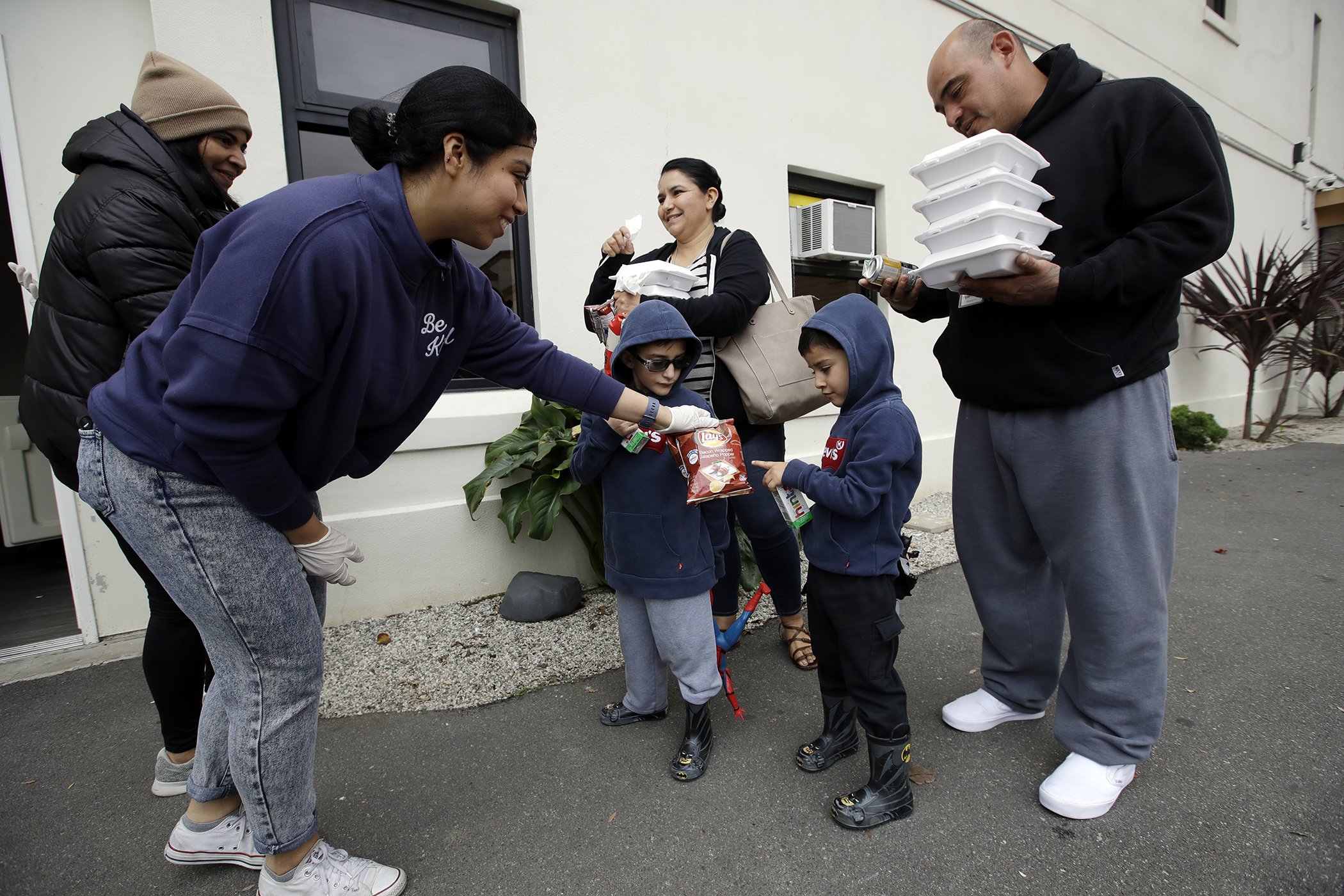The COVID-19 coronavirus pandemic is upending daily life for millions of people worldwide.
More than 194,000 infections have been confirmed so far and more than 7,500 people have died, according to the World Health Organization (WHO).
And that’s just the tip of the iceberg, WHO warns.
As the health crisis deepens, other crises are emerging. Lost jobs, mounting debts, looming evictions, and social isolation are just some of the disruptions societies are facing.
“One thing that the pandemic is doing is laying bare the lack of baseline universal infrastructure that is meant for all of us,” Celina Su, the Marilyn J. Gittell Chair in Urban Studies at the City of New York Graduate Center, told Global Citizen. “The pandemic could end up exacerbating inequalities and deepening poverty, but it’s also a canary in the coal mine by showing us in really tragic ways where we could all end up if we’re not as lucky later on.”
“It shows us what we should be working toward always, not just in times of crisis,” she said, calling for universal health care, free child care, paid sick leave, unemployment benefits, and a stronger social safety net.
Amid the growing crisis, communities are showing inspiring solidarity, helping the most vulnerable face challenges and building networks for long-term assistance.
“Right now, we’re supposed to be practicing social distancing, but how can we also practice social caring, social embracing, and social connection, all while physical distancing,” Su said. “What does that look like?”
Here are six ways communities are stepping up to support people and how you can join the relief effort.
1. Relief funds
As governments restrict public gatherings to slow the outbreak, businesses are getting shut down and people are losing their jobs around the world.
Many of these people — especially undocumented immigrants — have little savings and could lose their homes, run out of food, and be unable to pay essential bills for the foreseeable future.
Governments globally are developing emergency relief packages to ease the burden, but in the meantime communities are creating crowdsourced relief funds to help people in need.
The C19 Help Squad is providing immediate financial assistance to people throughout the US, while people in the UK have rallied to create more than 720 mutual aid groups, and crowdfunding sites like GoFundMe have set up dedicated pages.
Artists and activists are also among groups being impacted by the sudden cancelation of events, performances, and productions.
The music streaming service Spotify has launched the Spotify COVID-19 Music Relief project to help musicians who have been impacted by the pandemic. The company is matching up to $10 million in donations to a range of nonprofits helping musicians. Spotify is also working diligently to launch a feature that will enable artists to fundraise directly from fans during this challenging time. Soon, they will give artists the ability to drive listeners to a fundraising destination of their choice on their Spotify artist profile pages
The US-based Soze Foundation is partnering with TaskForce and Invisible Hand to launch an Artist and Activist Relief Fund, which has already raised over $21,000 to provide unrestricted $250 grants to selected applicants on an ongoing basis.
Some businesses that have been forced to shut down to prevent public gatherings are also setting up relief funds for their employees and to ensure they can return to work once the pandemic passes.
You can look for ways to help people in your community who are struggling financially by searching on social media, crowdfunding sites, or Google for local funds.
2. Food banks
 Volunteer, Pahola Campos hands out lunches to the Garcia family at a food distribution center set up by the Dream Center for those in need due to the coronavirus outbreak, March 16, 2020, in Los Angeles.
Volunteer, Pahola Campos hands out lunches to the Garcia family at a food distribution center set up by the Dream Center for those in need due to the coronavirus outbreak, March 16, 2020, in Los Angeles.
Volunteer, Pahola Campos hands out lunches to the Garcia family at a food distribution center set up by the Dream Center for those in need due to the coronavirus outbreak, March 16, 2020, in Los Angeles.
Food banks are a critical source of stability for any community facing a crisis — whether it’s a tropical storm, economic recession, or pandemic.
As the pandemic worsens, food banks around the world will face increased demand and fewer volunteers.
You can donate to local food banks in your area to help families in need and, if you’re fully able to, you can volunteer at them to help sort and deliver supplies.
3. Daycare
As schools close around the world, parents are struggling to find ways to supervise their children during the day — this is especially true for people working in essential sectors such as healthcare and food.
Once again, communities are rallying to support people in a bind.
People who are suddenly working from home indefinitely are creating impromptu daycares and traditional day care centers are extending their hours to meet the demand.
You can help by searching online and on social media for impromptu day care initiatives in your community that you can support if you’re healthy and able to, and by reaching out to friends, family, and neighbors who may need extra support.
4. Remote teaching
Students who are home from school also have to maintain their school work amid the pandemic so that they can pick up where they left off once the pandemic subsides.
For students with unreliable internet connections, unstable home residences, and other disruptions this will be extremely challenging.
The United Nations Sustainable Development Goal 4 is achieving universal, quality education by 2030. Part of the goal includes providing students with a consistent, stable place to learn, and the ongoing pandemic is undermining this previously certain variable for many students.
Some internet providers are making wireless connections free for students to ensure their school lessons can continue. Various educators are also providing virtual lessons and educational content to help students stay engaged while stuck at home.
Nonprofits like Scholastic, Save the Children, and UNICEF are stepping up to help students during this time. You can donate to these organizations, or support independent educators to promote education as the pandemic progresses.
5. Remote companionship
 A young boy plays his trumpet from a balcony, in Pamplona, northern Spain, Wednesday, March 18, 2020.
A young boy plays his trumpet from a balcony, in Pamplona, northern Spain, Wednesday, March 18, 2020.
A young boy plays his trumpet from a balcony, in Pamplona, northern Spain, Wednesday, March 18, 2020.
Social distancing is necessary to curb the pandemic. It’s also going to be isolating and emotionally draining for people worldwide who will be cut off from regular companionship.
In Italy, people have spontaneously orchestrated concerts from their balconies, while DJs and musicians are livestreaming sets for people.
Global Citizen has launched the #TogetherAtHome livestream series for musicians to share intimate concerts and create a sense of global community. So far, Chris Martin and John Legend have performed, with many more scheduled for the coming days. Check out our social media channels to find out who’s next, and tune in!
Meanwhile, virtual therapists have seen an exponential rise in demand, and friends everywhere are providing virtual support to each other.
You can help ease people’s isolation by checking in on friends and family members, and joining online communities to provide companionship to people who are alone.
6. Delivering goods and medicine
People who have COVID-19 or who are highly vulnerable to complications from it are advised to stay away from crowded areas. That presents an obvious dilemma: how are they going to get food and medical supplies?
Fortunately, volunteers are stepping up to meet the demand and assist people who are unable to use regular delivery services for financial or other reasons.
In Colorado, college students have created a service called “Shopping Angels” to shop for groceries and then deliver them to elderly people. In the UK, mutual aid groups are delivering medicine to people in need.
You can join these efforts by either delivering supplies to elderly people in your life, or by supporting groups that are providing this service — look online and on social media to find out about groups in your community.
“The most vulnerable don’t always have smart phones or internet access, so we have to figure out different nodes of connection,” Su said. “We have to figure out what their needs are and if we can connect existing resources to existing needs, and where there are needs beyond what we can provide as communities, we have to articulate these needs to elected officials.”
While community efforts to support each other are vital, we also need action from governments to ensure all countries have the capacity and resources to reach people who need assistance.
You can join Global Citizen in calling on governments to contribute more resources to the fight against the pandemic through our Together At Home campaign here. You can also take further actions like educating yourself about COVID-19 and how to stay healthy, and supporting and spreading the world on social media about the World Health Organization’s COVID-19 Solidarity Response Fund.
Su said we can also use this opportunity to reimagine the social contract, to reflect on the ways in which we are all interconnected, and how we can ensure society works better for all us in the aftermath of the crisis.
“We have to change our mindset,” Su said. “We’re all in this together. This pandemic shows how none of us deserves [to suffer].”
She added: “This crisis is about asking what do we all want for the future, and what lessons can we take with us for future crises to better care for each other and to think about solidarity.”
You can see all of Global Citizen's COVID-19 coverage here.
Related Stories